

Making Sense of Incense
| Perfume and perfumery – for as long as ancient civilisations have been around, humans have been concocting aromatics not only to use on themselves, but to scent a room, and to provide healing and relaxation. Across Central Asia, Egypt and the Indian sub-continent, humans have been practicing the art of making perfumes since as early as 3300 BC, by distilling spices, herbs and flowers into scented oils. |
|
Japan, too, has had a long history of making and using fragrances. However, instead of scented oils, the foundation of Japanese scents and incense is fragrant wood. Fragrant wood, known as koboku (香木) in Japanese, are woods that give off pleasant aromas. These fragrant woods are heated so that they produce their fragrance without emitting a single ribbon of smoke. Most fragrant woods have to be heated in order for the aroma to be released, but some types smell good as is, and as such are used to make items such as folding fans and prayer beads.
Some fragrant woods used in Japan include: sandalwood, known as byakudan (白檀), is one of the oldest knowns fragrant woods and is highly prized for its sweet and warm fragrance, as well as its antiseptic and insect repellent properties; agarwood, which fills with a natural resin when fighting a fungal infection, produces a rich scent known as jinko (沈香); and Japanese cypress (hinoki/檜), which has plenty of properties that make it an attractive wood to build with as well as to make scents with. Although these fragrant woods can be used on their own, they can also be made into incense by combining them with the powdered bark of the Japanese Bay tree, which is odourless and helps the fragrant materials burn evenly. The first recorded use of fragrant woods in Japan was in the late 6th century, shortly after incenses was introduced as an implement of Buddhist practices. Later during the Nara Period (710-794), the use of fragrant wood incense spread from temples and prayer halls to the courts, where courtiers made balls of incense that they would then use to scent their clothes, hair, and rooms. Women scented their kimono robes overnight by laying them on a frame over an incense burner. They would also use the same method to scent their long hair. By the time the Heian Period (794-1185) rolled around, incense had become a staple in the court, giving rise to “incense culture” among the aristocrats. This great appreciation for incense gave rise to kodo (香道), the art of incense burning. Like other traditional art forms like tea ceremony (chado/茶道) and flower arrangement (kado/花道), kodo gatherings are where participants come together to appreciate fragrances. Though there are certain etiquette rules to be observed during these gatherings, they are typically not as strict as that of tea ceremonies, and interactive games are an integral part of these gatherings. Participants at kodo gatherings take turns to smell incense from an incense burner and discuss the scent – they are encouraged not only to smell the incense, but to experience the scent of the incense with their whole body. These sessions are led by a master; these masters are the ones in charge of preparing the scents. They heat a piece of charcoal and place it in cup-sized incense burners filled with ash. Fragrant woods, incense pastilles (neriko/練香), or pressed incense (inko/印香) are then buried in the ash, leaving on a small hole for the scent to escape. A burner made of a sheet of mica and hemmed with silver is placed over the hole. To appreciate the scent, participants hold the cup in one hand, partially cover the cup with another and inhale through the hole between the forefinger and thumb. They may also play games during these sessions. One common game involves scent guessing: participants are made to smell incense from five different burners, after which, they have to determine which burners have the same scent and which have different scents. Their answers, as well as the actual answers, are recorded in geometric patterns. There are many variations of this game, one of which requires players to match the pattern of these scents to chapters of “The Tale of Genji,” a classic work of Japanese literature. |
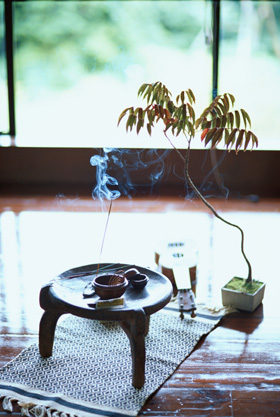 © ear-man-inc/orion/amanaimages 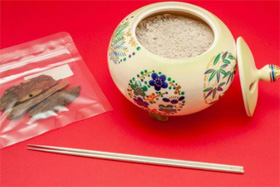 © photoAC 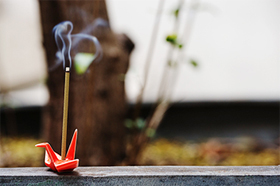 © Web Japan 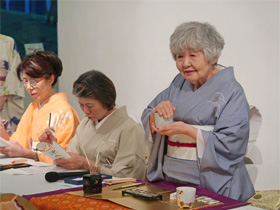 © JCC 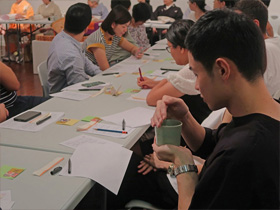 © JCC |
|
Incense, and fragrances in general, also feature in the daily lives of Japanese people. Fragrances made of natural materials can be appreciated through products like pressed incense and incense sticks, known as osenko (お線香). Pressed incense come in motifs of seasonal objects, like flowers and birds, and are used as interior decorations around the home as they give off a faint fragrance even before it is heated. Incense also comes in various shapes like cones and coils; coils burn much longer than other shapes, and as such as are used in larger rooms.
These fragrances can also be carried around in little scent sachets, known as nioi-bukuro (匂い袋). These pouches are made of colourful silk, and can be worn underneath clothes or placed in drawers and shoeboxes where, after some time, the scent will transfer to clothes and shoes. Traditional sachets were made using sandalwood, cloves, cinnamon and star anise, but nowadays, scents from dried flowers and herbs are also used. You can make your own scent sachets with leftover fabric and string, and a fragrance of your choice! When the scent fades, it can be easily refilled with a fresh fragrance, making it as good as new. The unique and enduring legacy of fragrances in Japan lives on through traditional practices like kodo, and as well through traditional products updated for use in modern times, such as osenko and nioi-bukuro. If you are in the market for a new scent for yourself or a fresh fragrance for your space, why not try fragrant woods and Japanese-style incense for a truly Japanese olfactory experience? |
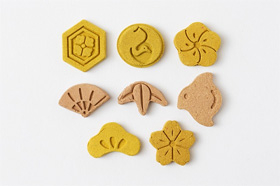 © Web Japan 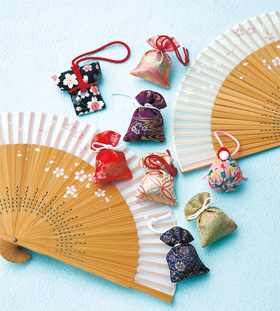 © Kuribayashi Shigeki |
Resources
|
Beautifully Fragrant Incense. Retrieved 30 August 2021, from https://web-japan.org/trends/11_fashion/fas160928.html |
|
Japan Creative Centre 4 Nassim Road, Singapore 258372 +65 6737 0434 / jcc@sn.mofa.go.jp https://www.sg.emb-japan.go.jp/JCC/ Nearest parking at Orchard Hotel & Delphi Orchard |
 |